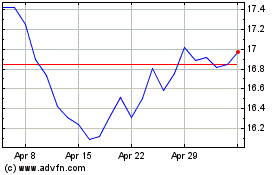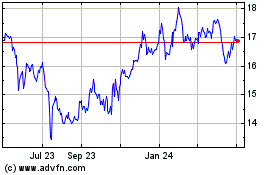Stankey to take reins from Stephenson just as new streaming
service set to launch
By Drew FitzGerald
This article is being republished as part of our daily
reproduction of WSJ.com articles that also appeared in the U.S.
print edition of The Wall Street Journal (April 25, 2020).
AT&T Inc. Chief Executive Randall Stephenson said he will
step aside at the end of June, handing leadership of one of the
world's largest media and telecommunications companies to longtime
deputy John Stankey.
Mr. Stephenson, who turned 60 this week, has spent most of his
13 years as chairman and CEO piecing together a modern media
business by scooping up DirecTV and then Time Warner, remaking the
telephone company that launched his career.
He had long been preparing to retire at some point this year but
in October said he would remain in charge through "at least" 2020
after an activist investor challenged his strategy. After a truce
was brokered, the succession planning proceeded, setting the scene
for Mr. Stankey to take over just as the company's new streaming
service, HBO Max, is slated to launch.
"John will be an outstanding CEO for this company, and I
couldn't be more confident or pleased in passing him the baton,"
Mr. Stephenson said of his successor in a video to AT&T's
staff.
Mr. Stankey, like the man he is succeeding, earned his stripes
in the telephone business but has been a leading proponent
AT&T's hard turn toward entertainment. "The entire industry is
in transformation right now and that transformation extends beyond
just the business model," Mr. Stankey said in a recent interview.
"It's how markets and how corporations operate."
The company next month will launch its new streaming video
service built atop its HBO brand, aiming to tear more customers
away from competing services, including those of Netflix Inc. and
Walt Disney Co.
HBO already benefits from a base of more than 30 million U.S.
customers and is expected to grow even in a crowded market for
entertainment. But the company is racing against time as the user
base for its more traditional satellite-TV and cable video units
collapses.
Advertising, another plank of AT&T's strategy, has failed to
deliver the explosive growth executives had hoped their new media
assets would deliver. The head of the company's ad unit left
earlier this year. And AT&T is facing an enlarged wireless
rival following the merger of T-Mobile US Inc. and Sprint Corp.
Mr. Stephenson said he will remain chairman until January, when
the Dallas-based company is expected to elect an independent
chairman. The change was announced at AT&T's annual meeting
Friday, which was held online because of the coronavirus
pandemic.
His exit comes after the company reached a truce with activist
investor Elliott Management, which had been pushing for a strategic
review of assets and questioned Mr. Stankey's elevation to heir
apparent. Last year, AT&T promoted Mr. Stankey, then the head
of its media unit, to No. 2 role as chief operating officer.
After reaching the truce with Elliott, AT&T said Mr.
Stephenson would stay at the helm through this year.
Elliott manager Jesse Cohn said on Friday the hedge fund
supports the succession move. "We have been engaged with the
company throughout the search process," Mr. Cohn said in a
statement. "We look forward to working with John as he begins his
term as CEO."
AT&T said the leadership change came after a five-month
search process overseen by the company's independent board members,
which evaluated external and internal candidates. Mr. Stephenson
said the board began its succession planning in 2017 and the
decision to promote Mr. Stankey was unanimous.
The handoff is the latest in a series of high-profile CEO shifts
in recent months as the rise of video streaming blurs the already
fading distinctions between the media and telecom worlds. Robert
Iger, the longtime leader of Walt Disney Co., stepped aside as CEO
in February to serve as executive chairman. Comcast Corp. named
Jeff Shell as CEO of NBCUniversal, replacing Steve Burke, who had
run the business since Comcast bought it in 2011.
Mr. Stephenson launched his career in 1982 with Southwestern
Bell Telephone in Oklahoma, where his older brother also worked as
a phone line repairman. The younger Mr. Stephenson has often said
he switched his college major of animal husbandry after recognizing
what breeding work would entail.
The future CEO rose through Southwestern Bell's financial arm as
it swallowed rivals. Mr. Stephenson later became the company's
finance chief and in 2007 took the reins of the renamed
AT&T.
After regulators thwarted the company's attempt to buy wireless
rival T-Mobile's U.S. arm, he looked to media and entertainment in
search of growth. In 2015, AT&T closed on the purchase of
DirecTV, a $49 billion acquisition that occurred near the peak of
the pay-TV market.
Then came the $81 billion takeover of Time Warner in 2018, which
the company secured after defeating a federal antitrust challenge.
The deal added HBO, CNN and Warner Bros. to the network operator's
stable of brands. It also saddled AT&T with more debt,
pressuring the company's shares.
AT&T held more than $170 billion of net debt at the end of
2018, making it the most-indebted nonfinancial company in the
world. The business has since whittled that down to about $150
billion through asset sales and refinancing.
Cord-cutting has sapped DirecTV, putting greater importance on
AT&T's plan for a new streaming service that can compete with
Netflix and other new video services. Its pay-TV unit lost another
one million subscribers in the March quarter, the company said this
week.
President Trump has complained about CNN's coverage of him and
his Justice Department tried to stop AT&T's takeover of Time
Warner. On Friday, he celebrated the CEO change on Twitter. "Great
News! Randall Stephenson, the CEO of heavily indebted AT&T,
which owns and presides over Fake News @CNN, is leaving, or was
forced out," the president tweeted.
An AT&T spokesman declined to comment on the president's
comments. Until recently, Mr. Stankey was in charge of the
WarnerMedia unit that includes CNN. AT&T recently hired former
Hulu boss Jason Kilar to lead WarnerMedia.
Mr. Stankey, 57, is a company veteran. He started in 1985 at
Pacific Telesis Group, another Baby Bell company created by the
court-ordered breakup of the original AT&T monopoly in the
1980s. Mr. Stankey spent years working with Mr. Stephenson after
its merger with Southwestern Bell. He championed both the DirecTV
and Time Warner deals and inherited leadership of each after
AT&T acquired them.
"I've worked very closely with John for well over 20 years. I've
asked him to take on some of our biggest challenges, and each time
he's delivered," Mr. Stephenson said in the video to AT&T's
staff.
Mr. Stephenson's tenure set AT&T on a different course than
rival Verizon Communications Inc., the other major company formed
from the remnants of the original Bell monopoly. Verizon focused
much of its investment on building and maintaining its lead in the
wireless business and made smaller digital media and advertising
acquisitions.
AT&T generated more than $181 billion in revenue last year,
most of which came from the company's wireless, internet and TV
businesses. In 2007, the year Mr. Stephenson took over, it had
about $120 billion in annual revenue and nearly 60% came from its
landline arm.
The company is one of the most widely held stocks in the U.S.
and one of the most generous in terms of dividend payments. While
its phone and internet services are in demand and insulated from
the coronavirus pandemic, AT&T warned this week that the crisis
is clouding its financial outlook as cash-strapped customers spend
less and TV production grinds to a halt.
The company on Wednesday withdrew the financial targets it gave
investors in November. It recently secured a short-term $5.5
billion loan to shore up its cash reserves and halted plans to buy
back $4 billion of its own stock.
On Friday, Mr. Stephenson said AT&T is committed to paying
its dividend, but declined to answer whether the company plans to
cut the payment. "We feel like the dividend is very secure," he
said during the company's annual meeting. "We're going to continue
that dividend."
Write to Drew FitzGerald at andrew.fitzgerald@wsj.com
(END) Dow Jones Newswires
April 25, 2020 02:47 ET (06:47 GMT)
Copyright (c) 2020 Dow Jones & Company, Inc.
AT&T (NYSE:T)
Historical Stock Chart
From Aug 2024 to Sep 2024

AT&T (NYSE:T)
Historical Stock Chart
From Sep 2023 to Sep 2024
